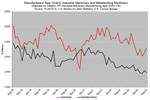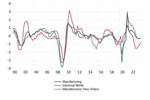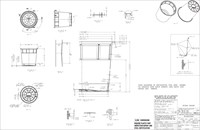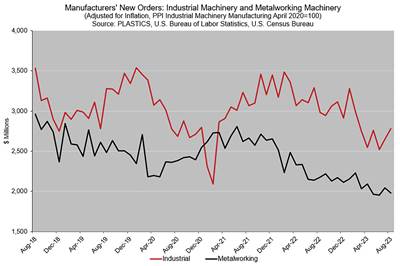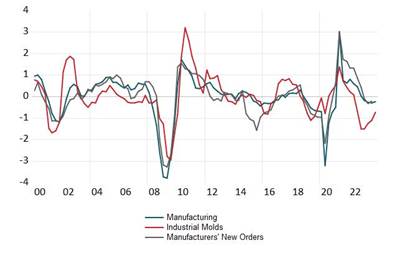
U.S. economy and moldmaking industry face mixed opportunities and challenges in 2024. Source | Getty Images
If you were at NPE last May in Orlando, Florida, you probably experienced the energy of the plastics industry firsthand. The event drew a record-breaking number of international attendees, first-time visitors and significant exhibit space. Both exhibitors and attendees gave positive feedback. This event coincided with a period of strength in the U.S. economy.
Is Q2 U.S. Economic Growth Sustainable?
The U.S. economy showed strong growth in the second quarter, expanding by an impressive 2.8% annually. This was a significant increase from the 1.4 percent growth in the first quarter and surpassed the predictions of many economists. The PLASTICS Quarterly Forecast released in July estimated 2.4% growth for the second quarter, while the Federal Reserve Bank of Philadelphia’s Survey of Professional Forecasters, which includes my own insights, had a median GDP growth forecast of 2.1%.
The strong economic growth in the second quarter was mainly due to a significant increase in Personal Consumption Expenditures (PCE). When adjusted for inflation, PCE rose by 2.3% annually, which was an improvement from the 1.5% growth in the first quarter. The growth in consumer spending was likely driven by increases in personal income. In April, personal income rose by 0.2%, followed by monthly increases of 0.4% in May and 0.2% in June. However, real disposable income, which is income after taxes and adjusted for inflation, only grew by 1.0%, weaker than the 1.3% increase in the first quarter.
When PCE grows faster than income, it usually means that personal savings are decreasing. The personal saving rate, which is the percentage of disposable personal income saved, dropped to 3.5% in the second quarter from 3.8% in the first quarter. Also, when consumer spending exceeds income growth, it typically leads to an increase in consumer debt. In the first half of the year, consumer loans (including credit cards and other revolving plans) increased by $19.9 billion, rising from 1,034.4 billion dollars in January 2024 to $1,059.3 billion in June 2024.
Considering the U.S. economy is outperforming other countries, 2024 could potentially see an improvement from 2023.
During the second quarter, business investment spending remained strong. Particularly, there was a $12.1 billion increase in spending on information processing equipment and an additional $26.2 billion was spent on transportation equipment. The growth in information processing equipment spending was mainly driven by businesses aiming to improve productivity by adopting artificial intelligence (AI). Considering that the latter includes high ticket prices, their aggregate investment tends to be magnified. It's important to note that investment spending on transportation equipment covers many items, including trucks, autos, aircraft, ships and boats and railroad equipment. However, investment in industrial equipment tells a different story, as there was a $2.1 billion decrease in spending on industrial equipment in the second quarter.
In the second quarter, the household sector remained active in the economy. However, some industries in the business sector were more productive than others. The PLASTICS forecast underestimated the resilience of the U.S. economy. In the latest projections, the U.S. economy is expected to experience a 1.7% real GDP growth in the third and fourth quarters of 2024, with a projected 1.8% growth for 2025. Similar to what was observed in the second quarter, there might be positive surprises.
What Does This Mean for Moldmakers?
Moldmaking typically moves in tandem with industrial equipment investment. A reduction in industrial equipment investment could signal a potential slowdown in new tooling projects. The PLASTICS Quarterly Forecast predicts a potential decline in mold production in 2024. However, plastics conversion has been on the rise, especially in the early months of 2024. According to PLASTICS' latest monthly business intelligence report, the monthly Plastics Demand Estimate shows that plastics demand reached $22.8 billion in May, marking a 1.4% increase from the previous month and a 3.5% increase from May 2023.
While plastics conversion is expected to grow this year, it might happen without additional investment in equipment or expansion of processors’ product lines. The capacity utilization rate in manufacturing plastics and rubber products has continued to decline, suggesting that new projects may be lagging and that existing capacity is sufficient to meet current and short-term demand. The capacity utilization rate has been below 80% since November 2022, decreasing to 74.9% in June of this year.
Additionally, moldmaking takes its cues from the overall manufacturing strength of the economy. It is no secret that 2023 was not the best year for manufacturing. The Industrial Production Index for manufacturing has been virtually flat since January 2023. While there were projections for a better year in 2024, the turnaround from the weak manufacturing environment of 2023 has been slow.
In June, the Industrial Production Index for manufacturing in the U.S. rose by 1.1% year-over-year. However, based on the S&P Global Manufacturing PMI, a measure of the manufacturing sector’s health, the U.S. Manufacturing PMI fell to 49.5 in July, below the growth threshold of 50, from 51.6 in June (S&P Global, July 2024). Another metric that mirrors such sentiment is the latest GBI Moldmaking from Gardner Intelligence, which was 43.2 in July, indicating softer-than-expected moldmaking activities.
Has Lackluster Manufacturing Been a Global Phenomenon?
The weak manufacturing environment is not isolated in the U.S. In the Eurozone, according to the Hamburg Commercial Bank (HCOB) Eurozone Manufacturing PMI, which is a leading indicator of business activity in Germany’s manufacturing sector, manufacturing dropped to 45.8 in June from 47.3 in May. Germany saw its Manufacturing PMI drop to 42.6 in July from 43.5 in May.
Concerning U.S. trade allies, particularly within the U.S. Mexico Canada Free Trade Agreement, the Manufacturing PMI in Canada stayed at 49.3 in May and June this year. Mexico, on the other hand, managed to stay above the growth threshold with Manufacturing PMI of 51.1 in June after 51.2 in May. Both countries are currently the largest export markets of the U.S. plastics industry. This is unlikely to change in the near future.
China’s Manufacturing PMI barely crossed the growth threshold at 51.8 in June from 51.7 in May (Caixin China General Manufacturing PMI, June 2024). Japan, on the other hand, dropped to 49.2 in July from 50 in June (au Jibun Bank Japan Manufacturing, July 2024).
All told, manufacturing is yet to shift into a higher gear. The International Monetary Fund now expects global economic growth to reach 3.2% this year followed by 3.3% next year. Advanced economies, however, could only see 1.7% growth this year and 1.8 percent next year. Considering that the U.S. economy is outperforming other countries, 2024 could potentially see an improvement from 2023. Additionally, the U.S. has lower economic policy uncertainty than other countries (See Figure 1).
However, three key factors to consider in the short-to-medium term could cap manufacturing growth for the remainder of the year.
-
U.S. Election Uncertainty
While historical data shows that U.S. manufacturing is unaffected by the uncertainty of an election year, the results of the election can significantly influence the sector and the overall business environment in the coming year. Critical areas such as trade policies, taxation on capital expenditures and incentives for research and development could undergo changes, impacting business expectations.
This uncertainty may lead to a cautious approach among businesses, with some delaying new projects until the post-election landscape becomes clearer. The anticipation of potential policy shifts and their effects on the economy might cause businesses to hold off on significant investments, potentially capping manufacturing growth.
-
Interest Rate Path
The Federal Reserve's decision-making process regarding interest rates remains complex, with the economy growing at a healthy pace above 2.8% and maintaining full employment. While the rate of price increases has slowed, inflation levels are still elevated. At the time of writing, the Fed has chosen to keep the benchmark interest rate in the 5.25 - 5.50% range. The Federal Reserve's cautious stance reflects a balancing act between supporting economic growth and containing inflation.
A potential rate cut might be constrained by robust economic growth, making it challenging for the Fed to lower rates without risking inflationary pressures. The current interest rate environment led to higher borrowing costs for manufacturers, slowing investment in new projects and expansion.
In the latest projections, the U.S. economy is expected to experience a 1.7% real GDP growth in the third and fourth quarters of 2024, with a projected 1.8% growth for 2025. Similar to what was observed in the second quarter, there might be positive surprises.
-
Labor Market Dynamics
The dynamics of the labor market are another critical factor for the manufacturing sector. A slowdown in the labor market could present mixed outcomes. On the one hand, it might provide the Federal Reserve basis to cut interest rates, potentially easing borrowing costs and stimulating investment. At the same time, a cooler labor market could reduce the difficulty manufacturers face in finding skilled workers.
The unemployment rate for the plastics and rubber products manufacturing sector, for example, rose from 0.4% in May to 5.2% in June. This increase in unemployment could indicate an easing in labor market tightness, which might alleviate some of the pressures on manufacturers struggling to fill skilled positions. In July, the unemployment rate in plastics and rubber products manufacturing decreased to 3.0%, as the overall unemployment rate increased to 4.3%. However, a significant slowdown could also signal broader economic weaknesses, which might dampen overall manufacturing activity.
Can Moldmakers Thrive Amid Economic Uncertainty?
As we move past the second quarter of 2024, the U.S. economy and the moldmaking industry face a mix of opportunities and challenges. While robust consumer spending and business investment have driven economic growth, uncertainties surrounding the upcoming U.S. election, the trajectory of interest rates and labor market dynamics pose potential headwinds. Despite slower growth in industrial equipment investment and a mixed global manufacturing outlook, the plastics industry’s resilience in meeting demand across various industries in the economy sustains a likelihood of growth for the plastics industry supply chain in the months ahead.
Read Next
Resilience and Reflections: Moldmaking in the Evolving Economic Landscape
As moldmakers navigate this complex year marked by fluctuating business activities, and approach the upcoming year with cautious optimism, three key considerations should guide their decisions.
Read MoreNavigating Economic Resilience and Consumer Trends
Consumer behavior provides mold builders insight into the evolving market dynamics of goods and services that helps strategic planning.
Read MoreShift in U.S. Mold Imports: Emerging Countries Gain Ground in Market Share
The dynamic nature of the U.S. mold industry's global trade landscape offers challenges and opportunities for growth.
Read More

